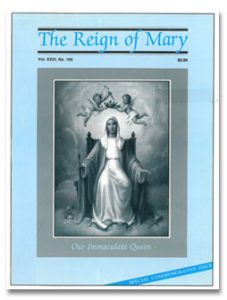Return to Back Issues Page
The Reign of Mary, Issue No. 100, Spring 2001
(Special Commemorative Edition)
This issue showcases some of the most significant articles written for The Reign of Mary in the past.
THE MASS
Should Devotees of St. Joseph Be Happy About the Insertion of His Name into the Canon of the Mass?
By Howard J. Earp; originally published in Reign of Mary #17, Spring 1972.
One hundred and fifty years ago marked the beginning of a movement which had as its goal the insertion of the name of St. Joseph in the Mass liturgy. Since that time, the proposal has been rejected by seven different Pontiffs....

Back issues not available
Invalidity of the Novus Ordo Missae
A Reply to William Most's Defense of the Novus Ordo; originally published inReign of Mary #29, Fall 1977
The editor was asked to reply and comment on a series of articles written by William Most, S.J, defending the Novus Ordo Missae against objections. We have taken the liberty to publish portions of the reply in this issue, as it may well serve to answer the questions of many wo have doubts on the subject....
How Ancient is the Canon of the Mass?
By Rev. Fr. Francisco Radecki, CMRI; originally published in Reign of Mary #70, Winter 1992
Did the Catholic Church in later ages compose the Canon of the Mass, or does the institution and composition of the Canon find its origin in apostolic times? The answer to this question is of paramount importance today....
THE RELIGIOUS CONGREGATION OF MARY IMMACULATE QUEEN (CMRI)
A Tribute to the Most Rev. Bishop Mark A. Pivarunas, CMRI
By the Very Rev. Father Casimir Puskorius, CMRI
Since his consecration nearly nine years ago, Bishop Pivarunas has provided the Church with two bishops, eighteen new priests, and has administered the sacrament of Confirmation to several thousand children and adults throughout the United States, Mexico, Canada, New Zealand, South America, and Europe....
The Religious Congregation of Mary Immaculate Queen
A Brief History.
All religious orders and congregations in the Catholic Church began as a small community of devout men and women united by simple guidelines. Over a period of time, each order adopted a Rule and Constitutions which were approved by the Church....
The Marian Priests
It is the goal of this Congregation to form the kind of Marian priest for which St. Louis Marie de Montfort prayed two centuries ago: “...true servants of the Blessed Virgin, who, like St. Dominic, would go everywhere with the bright and burning torch of the holy Gospels in their mouth and the Holy rosary in their hand...”
The Marian Brothers
Of the three categories of religious — priests, Brothers and Sisters — that of Brother seems to be the most overlooked. Why? The differences between a priest and a Brother are not properly understood....
The Marian Sisters
...the life of a Sister is primarily one of love and intimate union with Christ. As His spouse, she shares in the interests of His Sacred Heart. Like Him, she lives in poverty, simplicity, humility, and obedience. In union with Him, she sacrifices herself for the salvation of souls....
Vocation: A Call to Serve God
It is a mistake to believe that a vocation to the priesthood or the religious life must be so absolute and clear that it scarcely leaves any choice to the free will....
SEDEVACANTISM
Declaration Against Paul VI and the Enemies of the Church
Published in Reign of Mary #27, Fall 1976
The following Declaration, joined and signed by 18 French Traditionalist groups and organizations, was issued in France and distributed with No. 44 issue of Fr. Noel Barbara’s Forts Dans La Foi....
Sedevacantism
By Bishop Mark A. Pivarunas, CMRI; published in Reign of Mary #71, Spring 1992
Sedevacantism is the theological position of those traditional Catholics who most certainly believe in the Papacy, Papal Infallibility, and the Primacy of the Roman Pontiff, and yet do not recognize John Paul II as a legitimate successor of Peter in the Primacy....
“The Supreme Judge of the Faithful”
Originally published in Reign of Mary #56, Spring 1988
If Catholics wishing to remain loyal to the Church reserve to themselves the right to interpret the Code of Canon Law according to their own private judgment, they are setting up an authority in opposition to that of the Church, who alone has the right to interpret her laws.
The Assisi Gathering: “The Most Important Thing...”
Originally published in Reign of Mary #50, Fall 1986
On October 27, 1986, the world witnessed the spectacle of religious leaders from around the globe meeting in the little Umbrian village of Assisi to pray for peace. Some 160 representatives of various faiths answered the summons that John Paul II issued last January in Rome. Virtually all the religions invented by man were present....
An Expose of the Vatican II Decree Dignatitis Humanae
By Most Rev. Mark A. Pivarunas, CMRI; published in Reign of Mary #80, Spring 1995
...The reason this decree was the most controversial and the most destructive is that it explicitly taught doctrines previously condemned by past Popes. And this was so blatant that many conservative Council Fathers opposed it to the very end; while even the liberal cardinals, bishops and theologians who promoted the teachings of Dignitatis Humanae had to confess their inability to reconcile this decree with the past condemnations of Popes....
The Catechism of Ecumenism
By the Most Rev. Robert McKenna, O.P.; published in Reign of Mary #79, Spring 1994
The errors of the Wojtyla catechism are as subtle as they are numerous, just as is the case with the decrees of Vatican Council II. Indeed, the new Catechism is the Council’s teachings dodified, and the counterpart of the new Code of Canon Law promulgated in 1983.
